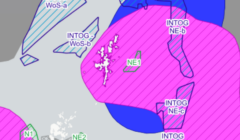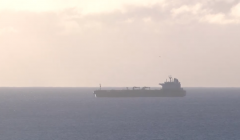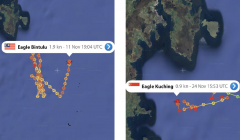Marine / Fishermen express concern over tankers sheltering too close inshore
THE LOCAL fishing industry has added its voice to concerns over the number of fully laden tankers “loitering” in the important and valuable fishing areas to the east of Shetland.
Executive officer of the Shetland Fishermen’s Association Simon Collins said he was grateful to local campaigner Jonathan Wills who brought up the issue in a recent Shetland News article.
Collins said: “All of us do welcome that he has flagged up the issue of these large ships sitting there full of crude oil when they shouldn’t.”
Dr Wills called on Shetland Islands Council to consider taking action against tankers leaving Sullom Voe Terminal after loading hundreds of thousands of barrels of crude and then sheltering off Shetland while waiting for orders and the oil price to rise.
The former councillor and honorary warden of the Noss nature reserve said while most of these tankers were well-maintained and well managed, accidents could happen even on good ships, and as such they posed an unnecessary risk to an island community dependent on clean seas.
Collins said fishermen were “extremely concerned” about the potential dangers.
“The fishing grounds to the east are important to local boats. These are the most productive fishing areas in the North Sea and we don’t need an incident involving oil,” the fishermen leader said.
While most of the waters around Shetland are marked as ‘areas to be avoided’, approaches to harbours such as Sullom Voe and Lerwick are classed precautionary areas which exist for “the purpose of ship’s routing”.
The council’s own Vessel Traffic Systems (VTS) manual says that “under an agreement with the Sullom Voe partner oil companies all tanker traffic heading to/or from Sullom Voe around the east side of Shetland must remain outside the precautionary areas on that side as if they were part of the area to be avoided.’
Become a member of Shetland News
Earlier this autumn the fully laden Eagle Bintulu spent two months as a floating oil storage facility within sight of the Noss nature reserve, while her sister vessel Eagle Kuching moved further offshore after the article was published on 27 November.
However, a request from Shetland News to Shetland Islands Council to clarify its approach to the issue and its jurisdiction remained unanswered.
Harbourmaster Greg Maitland said that “after careful consideration, we have no further comment to make”. A second request for comment with a number of questions remained unanswered.
Meanwhile, the Maritime and Coastguard Agency (MCA) clarified that the precautionary areas around Shetland have been designed to allow vessels to approach the ports of Lerwick and Sullom.
“Precautionary areas are not about prohibiting vessels from entering, they are there to ensure that vessels navigate with particular caution,” the MCA said.
“IMO’s [International Maritime Organisation] definition of precautionary areas is: ‘a routeing measure comprising an area within defined limits where ships must navigate with particular caution and where the direction of traffic flow may be recommended’.
“Vessels using a precautionary area are expected to comply with the conditions attached to it.
“The Maritime and Coastguard Agency can and does take up areas of concern with the ship’s crew, its owners and operators, as well as the flag states of the vessels, if need be.
“This is to enquire about transiting vessels’ well-being as the coastal state and generally accepted traffic management principals, and to reinforce their obligations under agreed IMO routeing measures.”
Dr Wills responded: “The MCA can say what they like but under the council’s own rules for Sullom Voe, tankers they MUST stay 20 miles off except when entering or leaving port.
Become a member of Shetland News
Shetland News is asking its readers to consider paying for membership to get additional perks:
- Removal of third-party ads;
- Bookmark posts to read later;
- Exclusive curated weekly newsletter;
- Hide membership messages;
- Comments open for discussion.
If you appreciate what we do and feel strongly about impartial local journalism, then please become a member of Shetland News by either making a single payment, or setting up a monthly, quarterly or yearly subscription.






































































